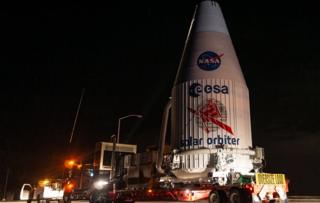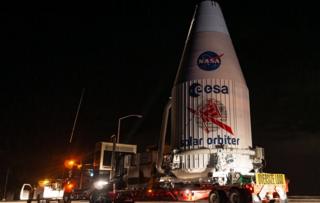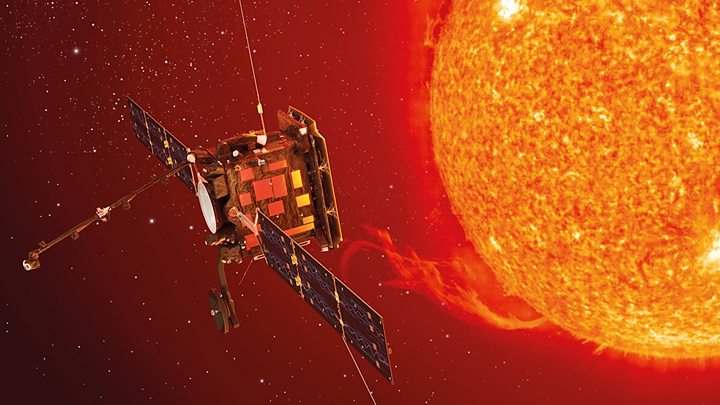Solar Orbiter completes preparation for launch
With all testing complete, Europe’s audacious mission to our star is placed atop its launch rocket. …

 Image copyright ULA/@GDavisPhotos
Image copyright ULA/@GDavisPhotos Europe’s grand mission to understand the detailed workings of the Sun is all but ready for launch.
Solar Obiter has been enclosed in its protective cover and mounted atop the rocket that will hurl the satellite towards our star next weekend.
SolO, for short, is a €1.5bn (£1.3bn) project of the European Space Agency (Esa) with a big input from the US.
Its goal is to help scientists better understand what drives the Sun’s dynamic behaviour.

Media playback is unsupported on your device
The spacecraft travelled out to Florida’s Cape Canaveral launch complex at the end of last year to begin a series of final checks.
But with those tests now complete and with Solo filled with a quarter tonne of fuel, engineers have cleared the probe for flight.
This resulted in Solo first being closed inside the 4m-wide, clamshell-shaped fairing that will protect the satellite as it ascends through the atmosphere to space.
Then, on Friday, the spacecraft was driven out to meet its United Launch Alliance Atlas rocket.
SolO was hoisted into position above the vehicle’s main core and Centaur upper-stages.
In the coming week, the Atlas will be rolled on to the pad at Cape Canaveral Air Force Station Space Launch Complex 41.
Lift-off is currently scheduled for 23:03 local time on Sunday 9 February (04:03 GMT on Monday 6 February).
Ian Walters is the programme manager for Solar Orbiter at Airbus, the pan-European aerospace manufacturer that has assembled this exquisite science satellite over the past decade.
“It’s an astonishing spacecraft,” he told BBC News.
“It’s got 10 instruments to study the Sun, but in reality each instrument is a consortium of different instrument packages. That gives Solar Orbiter tremendous capability but these different packages all have their own priorities.
“Some want no dust contamination, some want a very clean magnetic environment, some want to be cold, some want to be hot. All these conflicting design drivers we’ve been able to satisfy and deliver everything the scientists wanted.”
The Atlas rocket will send SolO on a path towards the inner Solar System. The spacecraft will then use gravitational flybys of Venus and Earth to get itself inside the orbit of Planet Mercury, just 43 million km from the Sun.
The probe will train its telescopes on the surface of our star, resolving details as small as 70km across. The pictures should be stunning – but they are just half of SolO’s science. The spacecraft also carries instruments to sense the constant flow from the Sun of charged particles and their entrained magnetic fields.
It is this combination of the remote sensing and in-situ measurements that should yield fresh insights on our star’s sometimes dramatic activity.
“We will probably unravel better the mechanism that is producing the magnetic field of the Sun and is also producing these huge explosions that are a worry for all kinds of infrastructure in space,” said Günther Hasinger, Esa’s director of science.
“The astronauts, for instance – if they really want to go to the Moon and Mars, they have to be wary of ‘solar weather’; but also the satellites and power stations which can be affected.”
From a British perspective, Solar Orbiter is arguably the most important space science mission in a generation.
The UK arm of Airbus assembled the probe. “More important in my opinion, we lead two instruments and have major roles on two others – out of the 10. So, it is a crucial validation of our world-leading role in solar physics science,” said Chris Lee, the head of science programmes at the UK Space Agency.
Financially, Britain has investment well in excess of €200m in Solar Orbiter.
Jonathan.Amos-INTERNET@bbc.co.uk and follow me on Twitter: @BBCAmos


